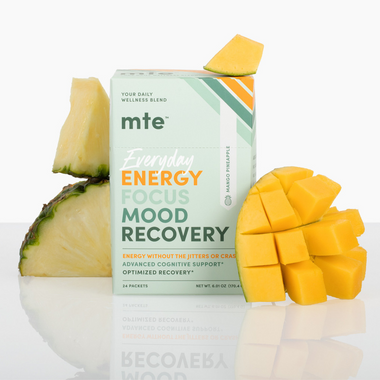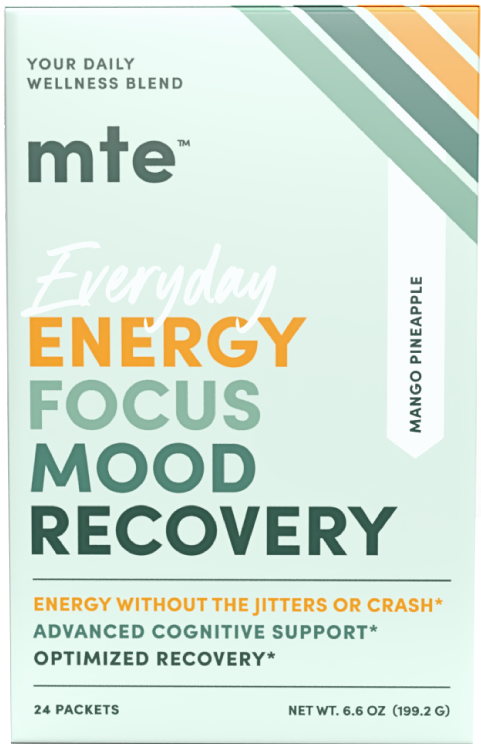
What Are Nootropics? A Complete Guide to Brain-Boosting Plants
Has your caffeine routine left you feeling foggy, fatigued, and kind of p*ssed off on a daily basis? Chances are that energy-boosting habit that used to help you clear up and zone in has become more of a hindrance than a help. It’s typical of caffeine – the up-down roller coaster, the tolerance, the dependence - the toxic cycle of it all. But what are we supposed to take to help us focus if coffee just isn’t cutting it anymore?
Nootropics!
Is it a buzz word? Maybe. Is it snake oil, though? Definitely not. Nootropics are pretty cool, but also a tad mysterious. So let’s unpack… well… everything about them – origins, functions, clinical support, and key nootropics we’ve stacked in our energy drink alternative for cognitive support.
Understanding Nootropics
Nootropics are a class of bioactive compounds that support, promote and even sometimes restore cognitive health. Also known as brain-boosters or cognitive enhancers, nootropics can be natural or man-made. Full disclosure, caffeine is technically a nootropic, but it sucks, so we aren’t going to talk about it like one, especially when there are so many better nootropics for energy out there.
While it’s no secret humans have loved to mess with their state of mind for millennia – tea, alcohol, opium – the term “nootropic” isn’t even 60 years old. Solidly Gen X. The term was coined by a Romanian psychiatrist in the ‘70s to describe newly-synthesized class of medical mind-altering compounds now used in psychiatry. He then established criteria for a substance to be considered a nootropic:
- Improves memory and learning abilities
- Aids cognitive function under stressful conditions – environmental, physical, mental
- Protects the brain from toxins – chemical, environmental
- Enhances innate cognitive processes
- Is non-toxic/safe for long-term use
- Doesn’t stimulate or depress brain function
A nootropic can be natural or manmade, and taken via prescription or self-administered. Nootropics like that OG synthetic compound are regularly used in treating mood problems as well as neurodegenerative and cognitive conditions. Recently, a native nootropic we could only observe in the lab, because it’s a byproduct of caffeine digestion, has been synthesized and made available for use in energy powders and wellness drinks - we’ll get to that in a bit.
It’s paraxanthine. We’re obsessed with it.
A Brief History of Nootropics
The modern concept of nootropics grew largely as a result of the emergence of adaptogens in the West in the ‘50s-‘60s. As discussed, nootropics were brought into the spotlight when the term was coined in 1972/3 to describe chemical substances that enhance cognitive functions, especially in contexts where cognitive function is damaged or impaired. At the time, they were looking for a way to synthesize GABA – the brain’s main inhibitory neurotransmitter. We like to refer to GABA as the calm-down chemical, because it quiets overexcited neurons but doesn’t make you tired.
Anyway, once they synthesized that first nootropic in the ‘60s, over the course of the next decade, a team of Romanian psychiatrists and medical researchers experimented with different compounds. Extensive studies found that this original class of nootropic:
- Protected against oxygen loss
- Increased interhemispheric communication
- Enhanced learning and memory
- Increased stimulatory threshold for stress
- Protected from electroshock (it was the ‘60s…)
- Was innate, meaning it did not alter EEGs, respiratory rates, heart rates, blood pressure, or blood sugar
But that’s not the extent of the history of nootropics. Consider coffee – that’s a nootropic. So is green tea. And those are used worldwide, and have been for thousands of years. A couple other well-worn-in nootropics include:
Bacopa monnieri
Also known as brahmi, this nootropic is native to India, where it’s played a medicinal role in Ayurveda for at least 2000 years. In Ayurveda, it’s classed as a medhya rasayana, Sanskrit that translates to “rejuvenator of the intellect”. Traditionally, it’s been used to treat:
- Seizure and movement conditions
- Chronic mood and affect difficulties
- Cognitive decline
- Arthritis
- Skin conditions
Clinically, Bacopa monnieri is thought to work by increasing the production of neurotransmitters that play key roles in learning, memory and higher-order thinking. It also demonstrates anti-inflammatory and antioxidant actions.
Centella asiatica
Known better as gotu kola, this nootropic is a tropical plant native to Asia, and has played an important role in both Indian Ayurveda and Traditional Chinese Medicine for over 2000 years. It’s such a powerful and multifaceted nootropic that it’s referred to in those practices as an elixir of life. Traditionally, it’s been used for things like:
- Cognitive disease/decline
- Adverse mood variations
- Nervous system conditions
- Liver health
- Cancer
Clinically, gotu kola is thought to work by increasing the production of collagen, which is a protein that helps to heal wounds and repair tissue. It also contains compounds known to have anti-inflammatory and antioxidant properties.
How Nootropics Work
So, how do these mysterious brain-boosting compounds work? Good question. Some are obvious; some are still mysterious. Because nootropics act on the central nervous system, their effects are thought to be a result of neuromodulation – balancing and optimizing communication, production, and activity of neurotransmitters, hormones, and other chemical signalers.
Along with their antioxidant and anti-inflammatory properties, nootropics basically clean up the brain’s infrastructure, making it easier to restore old damage and resist new damage naturally. Think organizing filing cabinets, clearing crowded aisles, and sweeping out dusty corners.
The main neurochemicals nootropics modulate are:
Acetylcholine
This neurotransmitter is the MVP of learning, attention, memory, and motor activity by manipulating the electrical activity of postsynaptic cells. Low levels of acetylcholine are associated with a variety of cognitive, neurological and neurodegenerative ailments.
GABA
GABA (gamma-aminobutyric acid) is the brain's calm-down chemical. It plays a vital role in regulating neuronal activity and maintaining a balance between excitation (alert) and inhibition (calm). Low levels of GABA are linked to more than a few symptoms, like stress, sleep problems, chronic mood challenges, cognitive difficulties, and more.
Glutamate
Glutamate is the main excitatory neurotransmitter in the brain. It plays a crucial role in many important brain functions, including:
- Learning and memory
- Cognition/focus/attention
- Sensory processing/perception
- Movement control/coordination
- Mood/emotional regulation
Low levels of glutamate can lead to cognitive impairments, such as memory loss and difficulty concentrating. High levels of glutamate can lead to excitotoxicity and neurological disorders.
And then there’s the serotonin of it all, which many nootropics affect directly or indirectly. When these neurochemicals are in balance and talking to each other the way they should, it can have a sizable effect on motor function, cognitive health, mood, and executive function.
Key Nootropics in MTE’s Pro-Focus Energy Powder
More Than Energy is a mental focus drink that replaces excessive caffeine and stimulants with a carefully-researched blend of nootropics for cognitive health and adaptogens for stress resilience. The nootropics we’ve stacked in our caffeine-free energy drink powder are backed by clinical evidence to promote attention, focus, clarity, mood, cognition, and more.
Let’s do a little rundown:
Paraxanthine
Okay so this is where we get to it - our beloved paraxanthine. Is it natural or synthetic? BSG had us spending the majority of the aughts asking the same question about cylons. The important thing is that it’s a compound our body already knows how to use, and that its synthesis now means you don’t have to consume caffeine to benefit from paraxanthine’s bioactive properties, which include:
- Stimulates adenosine receptors, dampening fatigue signaling
- Boosts cognitive and physical performance even in exhaustion
- Increases free dopamine, improving mood, motivation, and energy
- Is more effective than caffeine at promoting wakefulness but doesn’t raise resting heart rate, anxious feelings, or blood pressure
- Does not cause sleep rebound or mutagenic effects at high doses
GABA
Wait – isn’t GABA a neurotransmitter? Well, it’s also a nootropic! And a hormone… and an amino acid. Anyway, as higher levels of GABA lead to a calm that doesn’t come with tired, in research settings, GABA has demonstrated several nootropic and medical abilities:
- Calming an overexcited immune system
- Protects health of neurons and prevents neuronal death
- Inhibits metastasis in cancers
- Lowers blood sugar and blood pressure
- Anti-inflammatory and antioxidant
- Promotes liver and kidney health
L-theanine
Part amino acid, part nootropic, l-theanine is found in green and black tea leaves as well as a few bioactive mushrooms (not that kind). While it’s technically a nootropic, it also has adaptogenic properties, making it an ideal bridge between the adaptogen and nootropic stacks in our formula.
Medical research on l-theanine points to several abilities:
- Stress management
- Reduced tension/unease
- Elevated mood/reduced distress
- Reduced fatigue
- Enhanced cognition
- Immune system support
Saffron
A crocus plant native to Asia, saffron isn’t only a ridiculously-expensive cooking herb – not even close. In fact, it’s been used for millennia as everything from paint (literally 30000+ years ago) to perfume to tapestry threads to treatment for shingles. And, as it turns out, saffron also has nootropic properties.
The last 30 years of medical research on saffron support its health-promoting functions:
- Inhibits growth of cancer cells
- Reduces cognitive impairments and promotes hippocampal activity
- Protects the brain from oxidative stress
- Reduces and reverses DNA damage in vital organs
- Improves memory and cognition
- Reduces negative sensations of mood problems
- Reduces indicators of neurodegeneration
Chicory Root – Kind Of…
Chicory root, or rather the inulin it’s comprised of, is an insoluble fiber, meaning you can’t digest it. However, what inulin does is ferment in the gut to produce short-chain fatty acids, which are known to affect brain health in a multitude of ways. We use it as our source of fiber (and a sugar-free natural sweetener!), but as an SCFA, it has some clinically-backed nootropic properties, too:
- Anti-toxicity activity
- Restorative activity in the immune system
- Ability to reduce stress symptoms on the heart
- Improves blood flow to the brain
- Reduces inflammation in the brain
- Promotes growth and repair of neurons
- Improves gut health
Along with 5 adaptogens and superfoods, MTE harnesses the combined powers of these clinically-backed nootropics to support cognitive health, mood, balanced energy, focus, recovery at night, inflammatory response, and more. Nature’s already given us all the stuff we need to feel great – we’ve just gathered the best of it in a convenient paraxanthine energy powder so you can get it all in one spot.
Want to know more? Explore our Ingredients and Benefits pages for in-depth information on MTE’s formulation, and visit our Wellness Blog for more insight into nootropics, adaptogens, lifestyle, and more.






